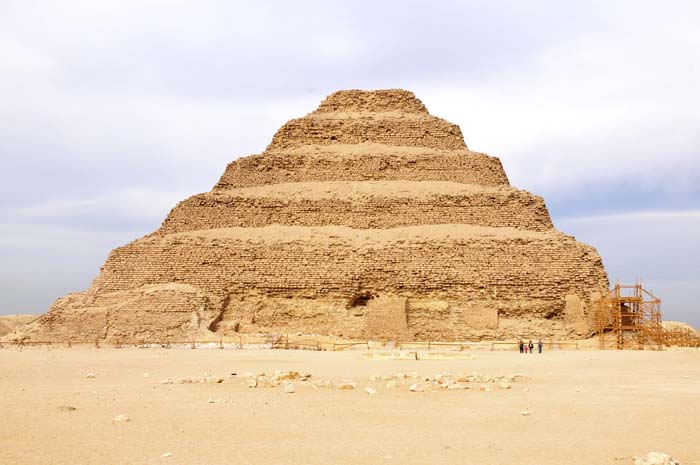

Hemiunu was a high-ranking official who lived during the reign of Pharaoh Khufu (Cheops in Greek). He was the son of Prince Neferma'at and Princess Atet, the grandson of Pharaoh Snefru, and the nephew of Pharaoh Khufu. Hemiunu served as vizier and royal seal bearer to Khufu and was probably responsible for building Khufu’s pyramid at Giza – the Great Pyramid.
Hemiunu is known for a well-preserved mortuary statue of him that was found within his tomb. Statues such as this could serve as a home for the soul of the deceased or as a means to worship their image. It would list the name of the departed as well as their titles. Hemiunu’s titles included: Member of the Elite, Vizier, King’s Seal-Bearer, Priest of Bastet, Priest of Shesmetet, High Priest of Thoth, Overseer of All Construction Projects of the King, and many others. The last is particularly interesting, as it indicates that Hemiunu was most likely the one responsible for building Khufu’s Great Pyramid.
The artistic style of Hemiunu’s statue is remarkable. Many depictions of people and deities were idealized to reflect a desire for perfection in the Afterlife and all eternity. Hemiunu seemed to take a much more realistic approach, which likely reflected how he actually looked. Instead of a young fit man, he appears a little older and corpulent, a sign of prosperity at the time.
Image: Hemiunu statue at the Roemer and Pelizaeus Museum, Germany.
Photo credit: By Einsamer Schütze- Own work, CC BY 3.0
Quirke, Stephen. Ancient Egyptian Religion. Dover Publications, Inc., New York, 1997.

Imhotep was an ancient Egyptian genius – a brilliant architect, mathematician, physician, astrologer, poet, priest, and Chief Minister to Pharaoh Djoser. Imhotep’s name means “the One Who Comes in Peace.” Although he was born a commoner, Imhotep rose to become King Djoser’s vizier and was in charge of building Djoser’s tomb at Saqqara. Rather than constructing a regular mastaba, or bench-shaped tomb, Imhotep chose to stack several mastabas on top of each other to create the famous Step Pyramid. Imhotep’s high standing in Djoser’s court is affirmed by an unprecedented honor - an inscription bearing his name on a statue of Djoser found at the site of the Ṣaqqara pyramid.
Imhotep was worshipped as a deity after his death, in Egypt’s Late Period and in classical times up until the seventh century CE. Temples and shrines dedicated to Imhotep were built in Memphis and Philae, where the wounded and ill would sleep in hopes that Imhotep would reveal a cure to them in their dreams. Imhotep was associated with the Egyptian god Thoth and the Greek god Asclepius, both of whom were gods of medicine and wisdom. While there is debate about how much and what kind of medicine he practiced in his lifetime, some contemporary scholars have attributed the founding of modern medicine not to the famous Greek physician Hippocrates, but to Imhotep instead.
Image: RC 1507 Imhotep Votive Figure at the Rosicrucian Egyptian Museum.
http://www.bbc.co.uk/history/historic_figures/imhotep.shtml
https://www.britannica.com/biography/Imhotep
https://www.louvre.fr/en/oeuvre-notices/imhotep-wise-deified
http://www.notablebiographies.com/Ho-Jo/Imhotep.html
http://www.telegraph.co.uk/news/science/science-news/3293164/How-Imhotep-gave-us-medicine.html
Much of what makes Ancient Egypt such a memorable time and place is its architecture. The Ancient Egyptians left behind some of the most impressive buildings of the ancient world. Among them, of course, are the Pyramids of Giza, but they are only part of the picture.

© Ed Yourdon - Djoser's Step Pyramid

Thousands of laborers were used to build the pyramids. Some historians claim they were slaves forced into working by cruel supervisors. Other historians say the workers were reasonably paid and happy to have a job. [Sources: Virginia Morrell, National Geographic, November 2001; David Roberts, National Geographic, January 1995]
Based on inscriptions describing the quantities of garlic, radishes and onions consumed, the Greek historian Herodotus wrote in the 5th century B.C. that a 100,000 laborers working simultaneously in three month shifts spent 20 years building the Great Pyramid of Khufu (Cheops).
Scholars now suggest that it probably took 20,000 to 30,000 men, setting stones at a rate of one every two minutes, approximately 20 years to set the 2.3 million blocks (five million tons of rock) needed to build the 481-foot-high Great Pyramid of Cheops. To prove this a team led by Egyptologist Mark Lehner of the University of Chicago built a 30-foot-high pyramid and then extrapolated how much labor was needed to build a larger one. Some say the work could have been done by as few as 500 hundred skilled craftsmen and 5,000 laborers.
The people who built the pyramids were likely made up of several thousand highly-skilled and well-paid craftsmen supported by thousands of manual laborers. Based on the number cattle, goats and sheep consumed it has been estimated that there were 6,000 to 7,000 workers at the site at one time, many times more if they only ate meat on special occasions. Supporting the pyramid builders were bakers, brewers and butchers and other service people.
Dr Joyce Tyldesley of the University of Manchester wrote: “All archaeologists have their own methods of calculating the number of workers employed at Giza, but most agree that the Great Pyramid was built by approximately 4,000 primary labourers (quarry workers, hauliers and masons). They would have been supported by 16-20,000 secondary workers (ramp builders, tool-makers, mortar mixers and those providing back-up services such as supplying food, clothing and fuel). This gives a total of 20-25,000, labouring for 20 years or more. The workers may be sub-divided into a permanent workforce of some 5,000 salaried employees who lived, together with their families and dependents, in a well-established pyramid village. There would also have been up to 20,000 temporary workers who arrived to work three-or four-month shifts, and who lived in a less sophisticated camp established alongside the pyramid village. [Source: Dr Joyce Tyldesley, University of Manchester, BBC, February 17, 2011]